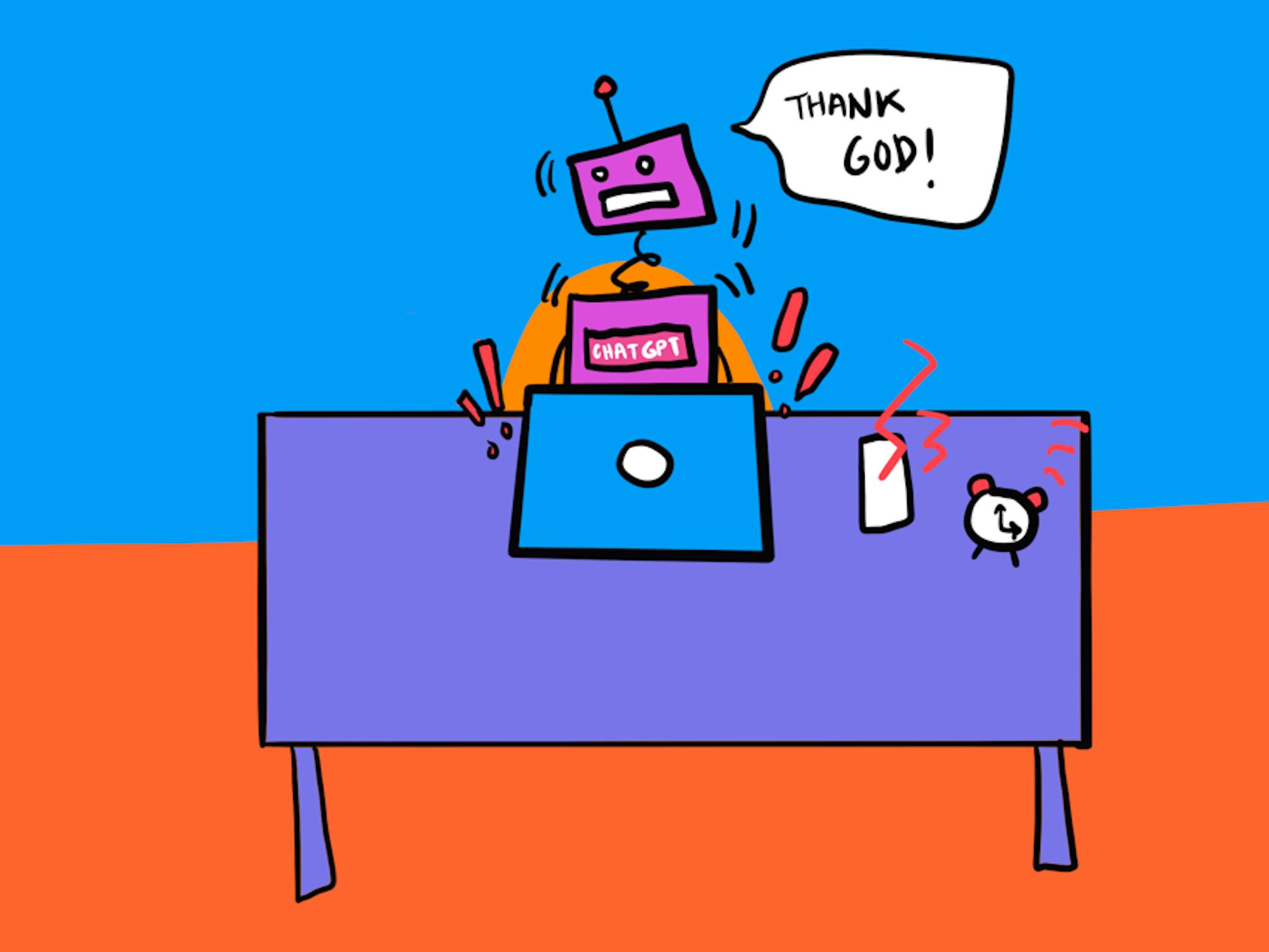Why Are We Polite to ChatGPT?
Do you have a coworker who has the answer to all of your questions? Who can help you rewrite an email in the exact tone you were going for or brainstorm a pitch deck in a matter of seconds? Who even knows the best underground spot in town for lunch? Any time of day, this colleague is just a click away, working like a well-oiled machine…
By now, you might’ve figured out who (or what) we’re talking about: ChatGPT.
At this point, 20% of us have welcomed this assistant into our offices, a whopping 8% jump from 2023 to 2024.1 Although you might be sick of them getting employee of the month, well, every month, you probably cannot help but say “please” when you approach them with a request or “thank you” when they get it right. It only makes sense to be polite!
Wait… does it make sense to be polite? This is a chatbot, after all, absent of any emotions—and yet over half of us find ourselves extending human courtesy to ChatGPT, according to an informal survey we ran on LinkedIn. Today, we’ll dig into why we’re polite to ChatGPT, whether it improves our outputs, and how artificial intelligence can actually help us create a more human workplace. (Ignoring the post-apocalyptic reality where it takes over our jobs…)
Disclaimer: No robots were harmed in the writing of this article.

References
- McClain, C. (2024, March 26). Americans’ use of Chatgpt is ticking up, but few trust its election information. Pew Research Center. https://www.pewresearch.org/short-reads/2024/03/26/americans-use-of-chatgpt-is-ticking-up-but-few-trust-its-election-information/#:~:text=The%20share%20of%20employed%20Americans,or%20for%20entertainment%20(17%25)
- Judkis, M., & Smilowitz, E. (2021, August 17). The voices we make when we pretend our dogs can talk. The Washington Post. https://www.washingtonpost.com/lifestyle/interactive/2021/voices-dog-human-connection/
- Karasu, S. R. (2023, June 12). On the face of it: Pareidolia. Psychology Today. https://www.psychologytoday.com/us/blog/the-gravity-of-weight/202306/on-the-face-of-it-pareidolia
- Luu, C. (2016, March 23). Personification is your friend: The language of inanimate objects. JSTOR Daily. https://daily.jstor.org/personification-is-your-friend-the-amazing-life-of-letters/
- Epley, N., Akalis, S., Waytz, A., & Cacioppo, J. T. (2008). Creating social connection through inferential reproduction. Psychological Science, 19(2), 114–120. https://doi.org/10.1111/j.1467-9280.2008.02056.x
- Pagel, M. (2017). Q&A: What is human language, when did it evolve and why should we care? BMC Biology, 15(1). https://doi.org/10.1186/s12915-017-0405-3
- Nosta, J. (2023, October 9). Artificial empathy: A human construct borrowed by ai. Psychology Today. https://www.psychologytoday.com/us/blog/the-digital-self/202310/artificial-empathy-a-human-construct-borrowed-by-ai
- Welivita, A., & Pu, P. (2024). Is ChatGPT More Empathetic than Humans? ArXiv. https://arxiv.org/abs/2403.05572
- Murez, C. (2021, November 22). Most parents say their kids aren’t thankful enough: Poll. HealthDay. https://www.healthday.com/health-news/public-health/b-11-22-most-parents-say-their-kids-aren-t-thankful-enough-poll-2655751068.html#:~:text=About%2088%25%20of%20parents%20regularly,and%20gratitude%2C%22%20Clark%20said
- Yin, Z., Wang, H., Horio, K., Kawahara, D., & Sekine, S. (2024). Should We Respect LLMs? A Cross-Lingual Study on the Influence of Prompt Politeness on LLM Performance. ArXiv. https://arxiv.org/abs/2402.14531
- Li, C., Wang, J., Zhang, Y., Zhu, K., Hou, W., Lian, J., Luo, F., Yang, Q., & Xie, X. (2023). Large Language Models Understand and Can be Enhanced by Emotional Stimuli. ArXiv. https://arxiv.org/abs/2307.11760
- Eliot, L. (2024, June 3). Does take a deep breath as a prompting strategy for Generative AI really work or is it getting unfair overworked credit. Forbes. https://www.forbes.com/sites/lanceeliot/2023/09/27/does-take-a-deep-breath-as-a-prompting-strategy-for-generative-ai-really-work-or-is-it-getting-unfair-overworked-credit/
- The subtle nuances of politeness: Cultural etiquette in language learning. Lingua Learn. (2023, June 23). https://lingua-learn.com/the-subtle-nuances-of-politeness-cultural-etiquette-in-language-learning/
- Wright, W. (2024, July 25). Please be polite to ChatGPT. Scientific American. https://www.scientificamerican.com/article/should-you-be-nice-to-ai-chatbots-such-as-chatgpt/#:~:text=As%20we%20train%20AI%20to,civil%20toward%20our%20fellow%20humans.
- Chartrand, T. L., & Bargh, J. A. (1996). Automatic activation of impression formation and memorization goals: Nonconscious goal priming reproduces effects of explicit task instructions. Journal of Personality and Social Psychology, 71(3), 464–478. https://doi.org/10.1037/0022-3514.71.3.464.
About the Author
Gabrielle Wasco
Gabrielle Wasco is Content Lead at The Decision Lab. She is passionate about translating groundbreaking research into engaging, accessible content to ensure behavioral science reaches and inspires a diverse audience. Before joining The Decision Lab, Gabrielle graduated from McGill University with a Bachelor of Arts in psychology and English literature, sparking her love for scientific writing. Her undergraduate research involved analyzing facial and body movements to help identify the smallest unit of nonverbal communication. In her free time, you may find her cross-country skiing or playing music in the park.
About us
We are the leading applied research & innovation consultancy
Our insights are leveraged by the most ambitious organizations
“
I was blown away with their application and translation of behavioral science into practice. They took a very complex ecosystem and created a series of interventions using an innovative mix of the latest research and creative client co-creation. I was so impressed at the final product they created, which was hugely comprehensive despite the large scope of the client being of the world's most far-reaching and best known consumer brands. I'm excited to see what we can create together in the future.
Heather McKee
BEHAVIORAL SCIENTIST
GLOBAL COFFEEHOUSE CHAIN PROJECT
OUR CLIENT SUCCESS
$0M
Annual Revenue Increase
By launching a behavioral science practice at the core of the organization, we helped one of the largest insurers in North America realize $30M increase in annual revenue.
0%
Increase in Monthly Users
By redesigning North America's first national digital platform for mental health, we achieved a 52% lift in monthly users and an 83% improvement on clinical assessment.
0%
Reduction In Design Time
By designing a new process and getting buy-in from the C-Suite team, we helped one of the largest smartphone manufacturers in the world reduce software design time by 75%.
0%
Reduction in Client Drop-Off
By implementing targeted nudges based on proactive interventions, we reduced drop-off rates for 450,000 clients belonging to USA's oldest debt consolidation organizations by 46%




















